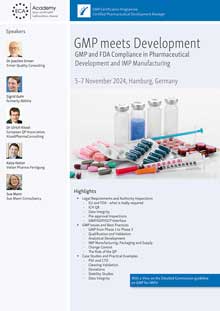MHRA´s Expectations during GCP Inspections

Recommendation
5-7 November 2024
Hamburg, Germany
GMP and FDA Compliance in Pharmaceutical Development and IMP Manufacturing
GCP inspections and how they are conducted has changed due to the increased complexity of trials, the use of electronic systems and the development of technology. However, the aim of a GCP inspection is still to ensure clinical trials are conducted safely and are producing accurate and reliable data. Recently, the MHRA shared their expectations for electronic systems used in clinical trials and what they want to see during GCP inspections.
Exchange of Documents and Access to Electronic Systems & Audit Trails
Regarding the exchange of documents and the access to eSystems the MHRA expects the following:
- If it is decided to work electronically an electronic repository / eRoom is likely to be required.
- When documents / data is made available in an eRoom there needs to be a mechanism in place for notifying the Inspectors that the document is now available.
- Documents should be provided in a way that is efficient and that answers are provided in full.
- Complete and direct access (without delay) will be required to all systems that make up the (e)TMF and potentially any key clinical trial support systems for example an eQMS System.
- Inspectors should be provided with the means to access and review all of the relevant systems.
- Computerized System Validation (CSV): Inspectors will also need to have access to systems that manage CSV systems, for example, helpdesk systems.
- The access to electronic systems should be read-only, but should not be otherwise limited, this includes access to Audit Trails. Audit Trails may also be requested to be extracted.
For more information please read the MHRA post GCP Inspections: Expectations and the dos and don’ts for hosting on MHRA´s Inspectorate Blog. In addition, the EMA recently issued a "Notice to sponsors on validation and qualification of computerised systems used in clinical trials".
Related GMP News
GMP Conferences by Topics
- General Quality Assurance and GMP Compliance Topics
- Hygiene
- General Microbiology Topics
- Regulatory Affairs
- Development
- General Analytics Topics
- Good Distribution Practice
- Sterile Manufacturing
- Computer Validation
- General Qualification/Validation Topics
- General Engineering Topics
- APIs/Excipients
- GMP Basic Training Courses
- Medical Devices and Combination Products
- Packaging and Packaging Material
- Data Integrity
- Qualified Person (QP)
- GMP Auditing
- Documentation
- Cleaning Validation
- General IT Compliance Topics
- Impurities
- OOS / OOE / OOT
- Material Testing
- Validation of Analytical Methods
- Analytical Instrument Qualification
- Stability Testing
- Microbiological Testing
- Technology
- General Manufacturing Topics
- Solid Dosage Forms/Semi-Solid Dosage Forms
- Biotechnology/Blood/ATMP
- Herbal Drug Products/Cannabis/Radiopharmaceuticals
- Others


